📄 Table of Contents
DeFi Is Huge!
As the crypto markets grows, so do the financial products available. There are multiple ways to earn interest on your coins and increase your holdings.
DeFi protocols and applications offer unique ways to earn without compromising on privacy. By participating, you’re not just earning but also contributing to the underlying projects and networks.
Finding these opportunities can be challenging due to the variety of protocols, coins, and tokens available. That’s where DeFi Llama comes in. It’s a popular tool that aggregates all decentralized opportunities under a single dashboard.
Instead of opening every single platform to compare rates, you can do it quickly using DeFi Llama, saving you a lot of time!
Keep reading this article to learn how to find opportunities in:
- Lending
- Staking
- Yield farming
- NFTs
- And much more.
What Is DeFi Llama?
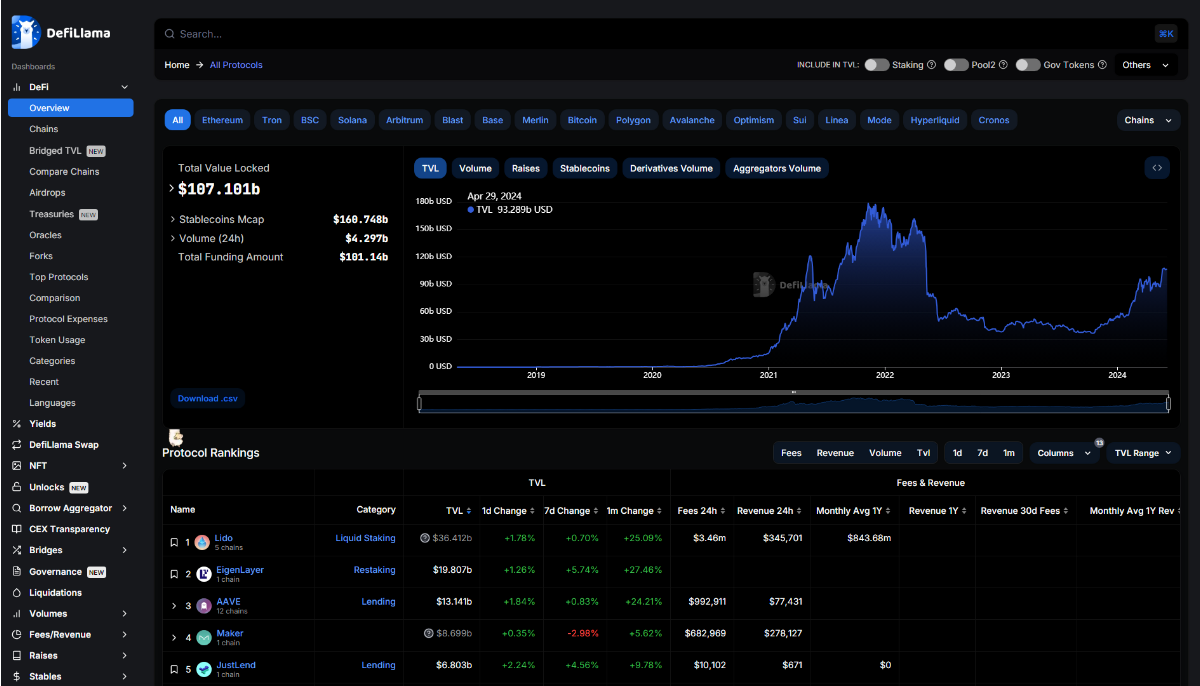
DeFi Llama is like a one-stop-shop for DeFi info, gathering details on projects and coins in one place. It helps you quickly find profitable DeFi opportunities by making research easier and faster.
With DeFi Llama, you don’t need to hop around different platforms. It’s all in one dashboard, making it simple to track and assess what’s happening in the DeFi world.
So whether you’re a seasoned investor or just starting out, DeFi Llama can help you navigate the complexities of DeFi with ease.
Why DeFi Llama?
DeFi Llama is a great choice for anyone interested in decentralized finance for a few key reasons.
Firstly, it makes it easy to explore a wide range of DeFi opportunities all in one place. Whether you’re looking into lending, yield farming, or other DeFi projects, DeFi Llama has you covered.
Secondly, it’s really good at organizing information so you can quickly understand what’s going on with different DeFi platforms.
Lastly, it saves you time by offering user-friendly tools and features that make managing your DeFi activities a breeze.
Understanding Key DeFi Concepts
TVL
TVL (Total Value Locked) shows how much money is invested in DeFi protocols. It tells us how popular and healthy these platforms are.
This metric can be used to gauge the amount of demand for the protocol’s services, as well as its potential revenue-generating capacity.
APY
APY stands for Annual Percentage Yields and it measures the total return on an investment over 1 year as a percentage of the initial investment.
It takes into account not only the interest rate offered by the protocol, but also any compounding effects that may occur, such as reinvestment of earned interest or rewards.
This means that APY can be a more accurate representation of the actual return that users can expect to earn over time, compared to a simple interest rate.
Tokens
Tokens are like digital money used in DeFi.
There are different types of tokens:
| Category | Description |
|---|---|
| Governance | Tokens for voting |
| Utility | For accessing services |
| Stablecoins | Keep a steady value |
Governance Tokens
These tokens give holders the ability to vote on proposals and changes to the protocol.
They empower users to participate in the decision-making process and shape the direction of the platform.
Utility Tokens
Utility tokens may be used to pay for transaction fees or access certain features within the protocol.
They serve practical purposes within the ecosystem, facilitating various activities and interactions.
Stablecoins
Stablecoins are tokens pegged to the value of a specific asset, such as the US dollar.
They provide stability and predictability within the protocol, offering a reliable medium of exchange and store of value amidst the volatility of cryptocurrencies.
Chain
A DeFi protocol is built on a blockchain network, which acts like a digital ledger recording transactions securely and transparently.
Each block in the chain holds numerous transaction records that become permanently stored.
Different DeFi protocols are constructed on various blockchain networks such as Ethereum, Binance Smart Chain, or Solana.
The choice of blockchain significantly influences the protocol’s functionality, security, and scalability to accommodate numerous users.
Impermanent Loss
Imagine you put two different cryptocurrencies into a pool for traders to swap between them.
As the prices of these cryptocurrencies change, the pool automatically adjusts by buying more of the cheaper one and selling the more expensive one.
This might leave you with less of the expensive cryptocurrency and more of the cheaper one, which can lower your total investment value compared to holding them separately.
This is called impermanent loss, which can be more pronounced when one cryptocurrency is stable and the other is volatile.
Despite earning trading fees, impermanent loss can lead to an overall loss, especially if you have a significant portion of your investment in the pool.
APY Trends
Comparing DeFi and traditional finance can be simplified by looking at APY trend charts. These charts show whether rates are increasing or decreasing.
However, it’s important to remember that APY isn’t the only factor to consider in DeFi investments, as there are different ways to earn yields.
Despite this, APY trend charts offer valuable insights into market trends. For pinpointing the best investment opportunities in DeFi, check the Spot APY distribution graph.
How To Make Money With DeFi Llama
If you’re looking to make money with DeFi Llama, the Yields section is where you’ll find most opportunities.
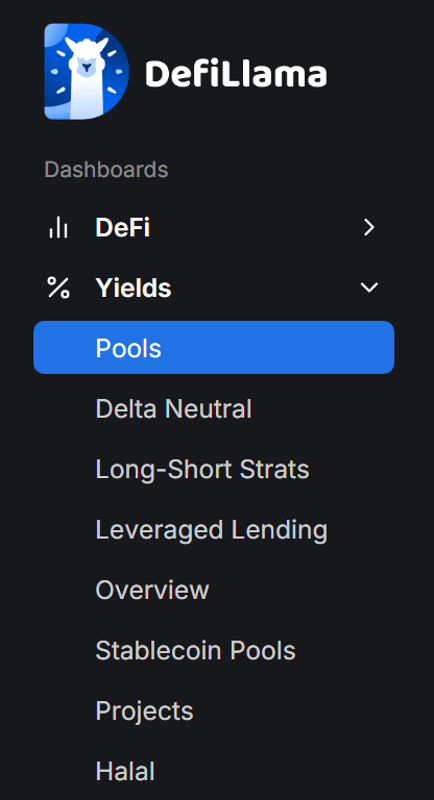
This includes things like:
| Category | Description |
|---|---|
| Pools | List all pools by TVL or APY, use filters for risk management and alignment with strategies. |
| Long-Short | Strategies involving buying and selling different assets for profit. |
| Delta-Neutral | Strategies aimed at keeping portfolio sensitivity to price changes close to zero. |
| Leveraged Lending | Earning higher yields by borrowing against deposited assets and redepositing them. |
| Borrowing | Borrow and invest elsewhere for better returns. |
| Stablecoin Pools | Pools consisting of stablecoins to minimize volatility. |
| Projects | Explore various protocols like Lido, JustLend, Camelot, AAVE, etc. |
| ETH Liquid Staking | Earn staking rewards while keeping ETH tokens liquid through protocols like Lido, Rocketpool. |
| NFTs | Tools for researching and flipping NFTs, explore collections, and view earnings metrics. |
| Airdrops | Earn free tokens by participating in various promotions and activities. |
Alternatively, you can look into the underlying protocols within DeFi to find ways to make money.
Let’s take a closer look at the earning opportunities mentioned on the list.
Pools
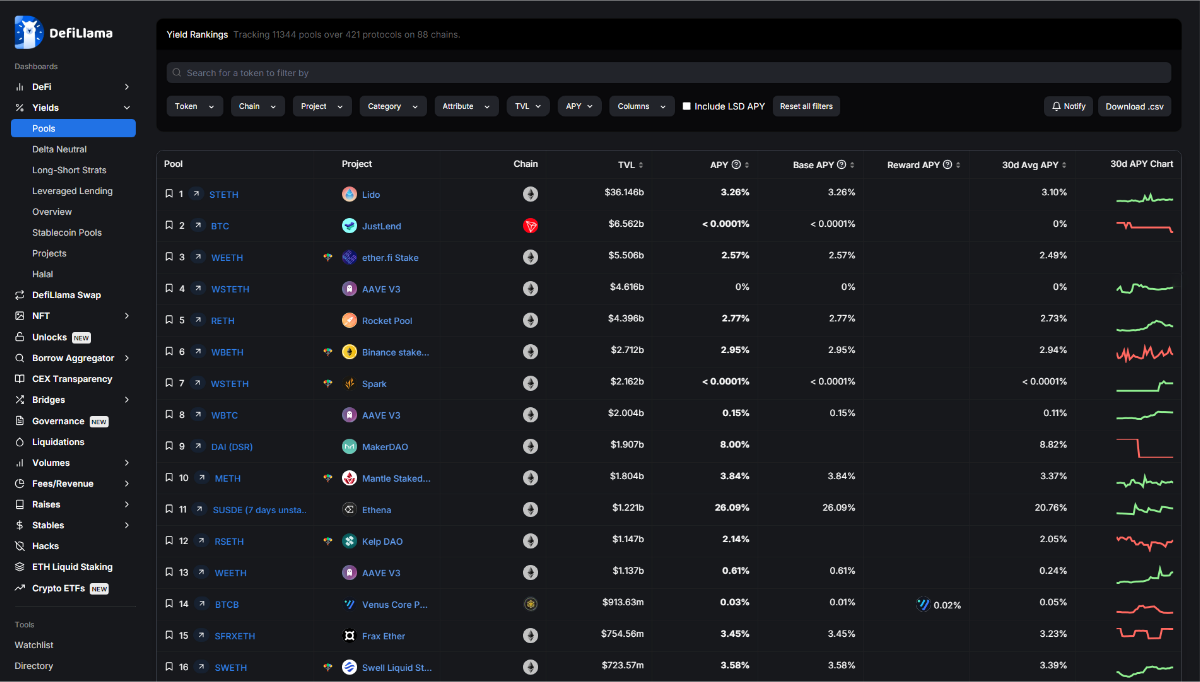
List all pools by TVL. Currently, Lido has the highest TVL and allows for liquid stacking, but it does not offer one of the highest APYs.
If you’re looking for the most rewarding pools, sort them by APY, but remember to consider the risks.
It’s hard to judge risk just by looking at APY percentages, but high percentages are often associate with more volatile assets or temporary market events (the APY can increase or decrease).
APY
If you have a target APY, you can use the APY filter to set a maximum and minimum, such as capping it at 30%.
Similarly, you can apply the same filtering to TVL to only display pools above a certain TVL number.
You can use other filters to show pools that align with your strategy.
Attributes
- Stablecoins: Only show stable coin pools
- Single Exposure: Pools with only one token
- No IL: Select pools with no Impermanent Loss
- Million Dollar: Pools with at least one million dollar TVL
- Audited: Pools from audited projects only
- No Outliers: Remove pools which are considered outliers based on their geometric mean of APY values
- Stable Outlook: Pools with Stable/ Up outlook only
- High Confidence: Pools with High predicted outlook confidence
- Potential Airdrop: Projects that don’t have a token yet and might airdrop in the future
As you can see a lot of these attributes can be useful to manage your risk exposure and filter out pools you think are too risky for you.
Categories
- Liquid Stacking
- Lending
- Dexes
- CDP
- Yield
- Derivatives
- Yield Aggregator
- Liquidity manager
- Algo-Stables
Project
This includes all available protocols to choose from including:
- Lido
- JustLend
- Camelot
- AAVE
- And more
Chain
Use the chain parameter to select the chain. There are multiple reasons one might one to choose a specific chain like avoiding high fees or use a chain associated with strong projects.
Token
You can select the actual tokens you want the pool to include, if you want to narrow down pools that include your favourite coins.
Earn
Once you’ve identified some pools, you can click on the pool or tokens to access more details and view graphs of TVL and APY, or check their audits.
To start earning rewards from a pool, navigate to the protocol and click on the arrow icon to open a new page of the Dapp or protocol. You can then locate your desired pool.
If you’re having trouble finding the same pool on the decentralized application, you can copy and paste the tokens into the search bar or search by one of them.
From there, the steps for DeFi are usually the same:
- Connect your wallet
- Select the funds you want to invest
- Approve the transaction, and you’re done
Stable Coins Pools

Instead of using filters, you can easily find stable coin pools by going to the Stable Coin Pools section. All the filters and sorting options are still available.
Delta-Neutral
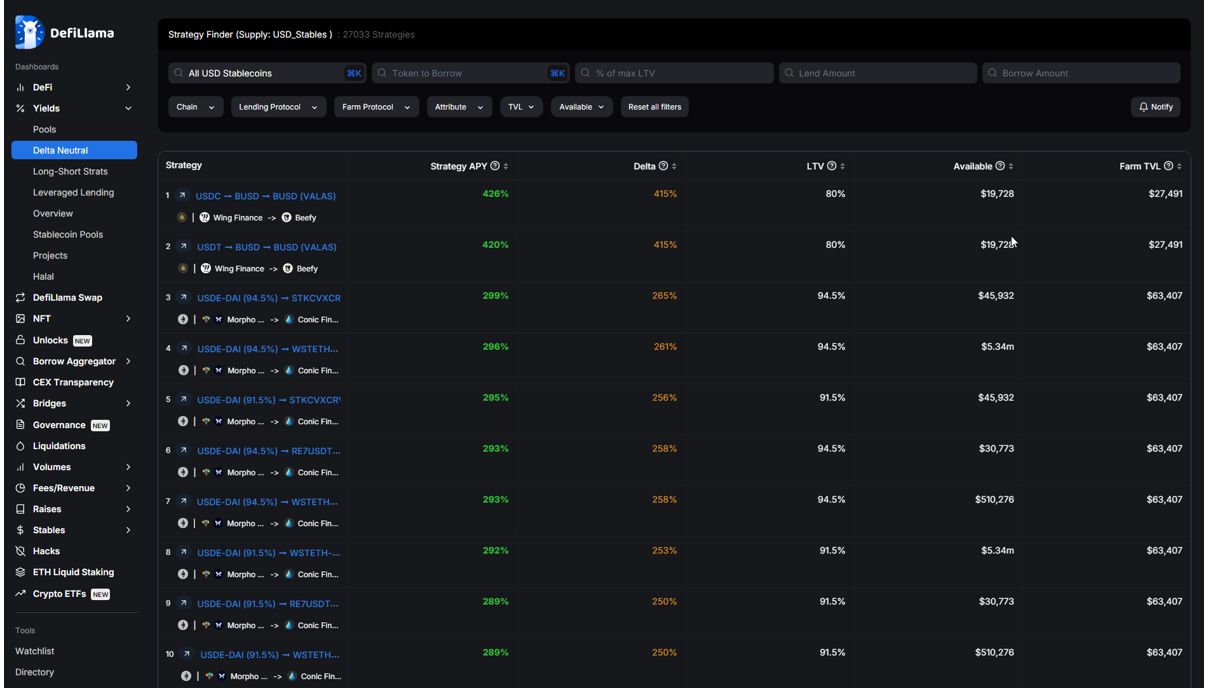
Delta-neutral strategy is a trading method aimed at keeping a portfolio’s sensitivity to price changes in an asset close to zero.
For example, let’s consider the delta neutral strategy involving FUSDT-DAI-DAI (SCREAM).
Suppose you have $1000 worth of FUSDT, a stablecoin tied to the US Dollar’s value.
| Step | Action | APY (%) | Notes |
|---|---|---|---|
| Lend FUSDT | Lend FUSDT as collateral on Granary Finance | 7.86 | Earn Supply APY |
| Borrow DAI | Borrow DAI against FUSDT collateral (80% LTV) | -3.65 | Interest to be paid for the loan |
| Farm DAI | Use borrowed DAI to farm on Acryptos | 316.59 | Earn farming rewards |
| Strategy APY | Combined APY | 258.21 | 7.86 - 3.65 * 0.80 + 316.59 * 0.80 = 258.21 |
| Earnings | Total earnings after a year on $1000 investment | $2,582.10 | End up with $3,582.10 in total after a year |
Lend FUSDT
First, you lend FUSDT as collateral on Granary Finance, earning a Supply APY of 7.86%.
Borrow DAI
Second, you borrow DAI against your FUSDT collateral with a maximum Loan-to-Value (LTV) ratio of 80%. The borrowed APY is -3.65% (the interest you need to pay for the loan).
Farm DAI
Third, you use the borrowed DAI to farm on Acryptos and earn 316.59%.
Strategy APY = 7.86% - 3.65% * 0.80 + 316.59% * 0.80 = 258.21%
If you invested $1000, you would make a total of $2,582.10 after a year, ending up with $3,582.10 in total.
Long-Short Strats
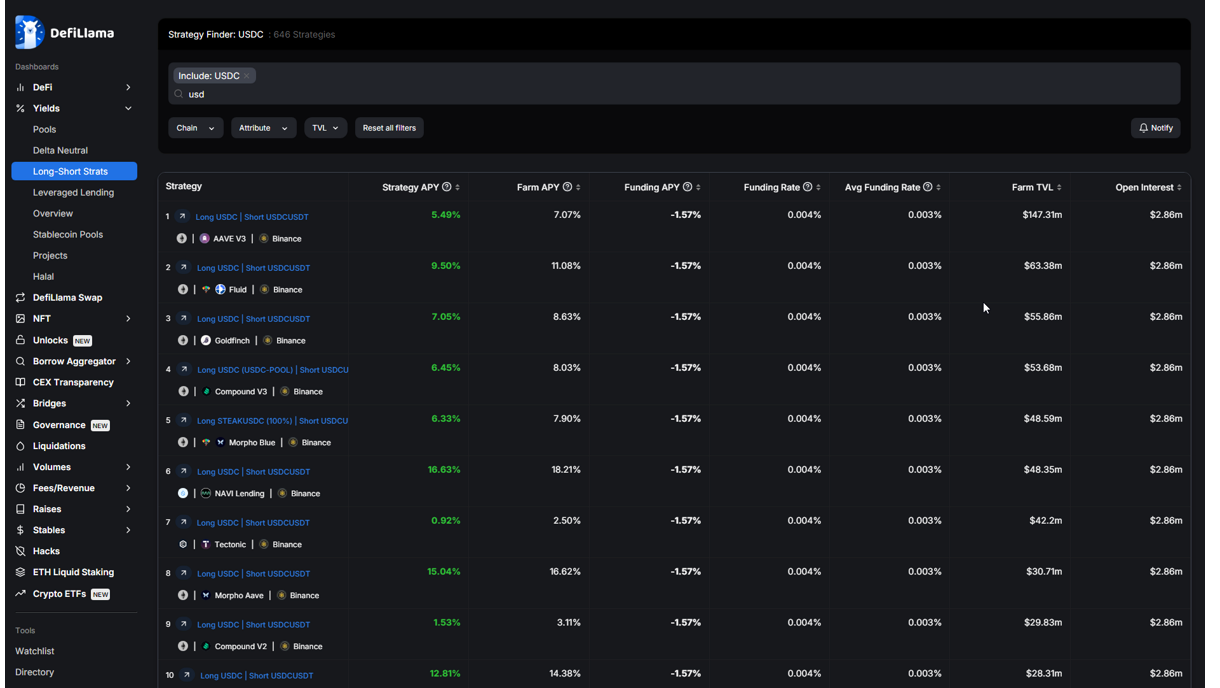
A long-short strategy in DeFi involves both buying (long position) and selling (short position) different assets to profit from their price differences.
Let’s take the pair below as an example, to explain how this strategy works.
Long USDC | Short USDCUSDT
Here, the trader takes a long position in USDC and a short position in the USDCUSDT pair. USDC is pegged to the US dollar, while USDCUSDT represents the exchange rate between USDC and USDT, another USD-pegged stable coin.
The goal is to profit from USDC’s price increase relative to USDT. If USDC rises, the long position gains, but the short position in USDCUSDT loses. Conversely, if USDC falls, the short position gains while the long position loses.
To execute, the trader might use a decentralized exchange (DEX) like Compound for the long position and a centralized exchange like Binance for the short.
Specifics like position sizes and timing depend on the trader’s goals and market conditions.
Leveraged Lending
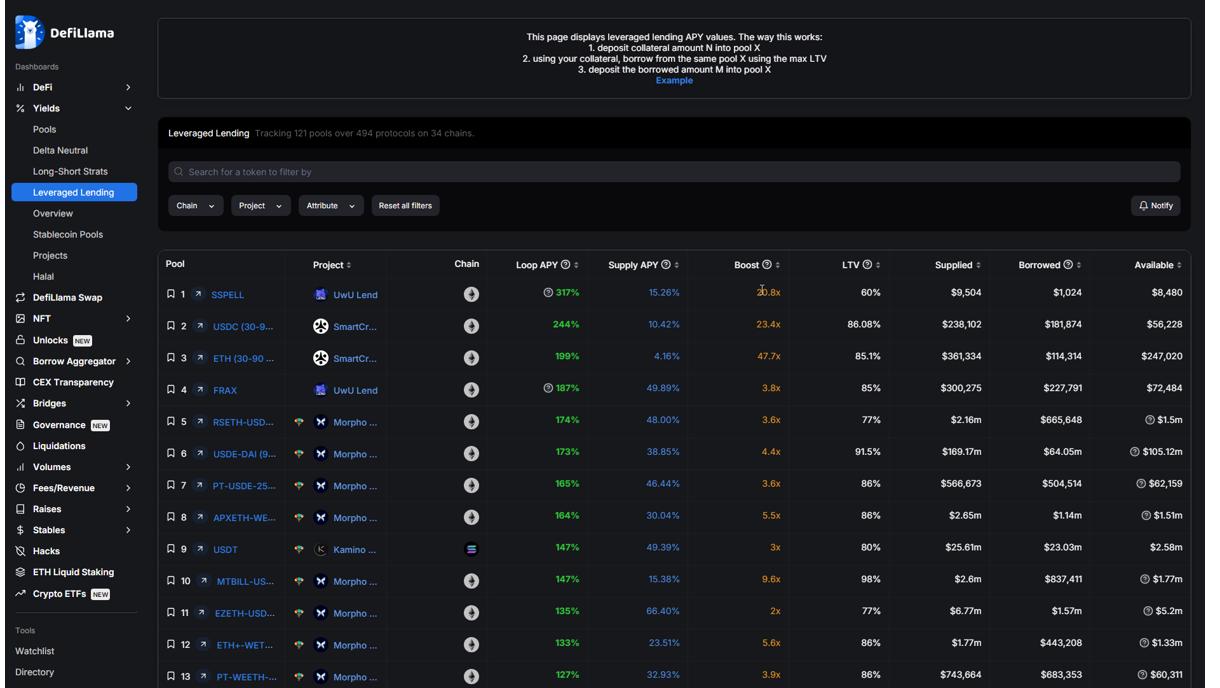
In DeFi, leveraged lending lets users earn higher yields on their deposited assets by borrowing more against their collateral. They then redeposit the borrowed assets into the same pool.
| Step | Action | Amount | APY (%) | Notes |
|---|---|---|---|---|
| Initial Deposit | Deposit as collateral into the pool | $1,000 | 9 | |
| Borrow | Borrow from the same pool using deposited collateral as security | $750 | -3 | Based on a maximum Loan-to-Value (LTV) ratio of 75% |
| Redeposit | Redeposit borrowed amount into the same pool | $750 | ||
| Total Deposit | Total amount deposited after borrowing and redepositing | $1,750 | 1.75 times the original amount | |
| Loop APY | Calculated annual percentage yield on deposited and borrowed assets | $1,750 | 18 | Loop APY = (9% * 1.75) + (3% * 0.75) = 18% |
| Earnings | Annual yield on deposited collateral and borrowed assets | $1,750 | 18% | Twice the Supply APY of 9% without borrowing |
In the example provided:
- Deposit: $1,000
- Supply APY: 9%
- Borrow APY: 3%
- LTV: 75%.
Here’s how it works:
- A user deposits $1,000 as collateral into the pool.
- They borrow $750 from the same pool, using their deposited collateral as security, based on a maximum LTV of 75%.
- The borrowed $750 is then redeposited into the same pool.
Now, the user has $1,750 deposited, 1.75 times the original amount, and has borrowed $750.
The loop APY, or the annual percentage yield earned, is calculated as the sum of the Supply APY on the total deposited amount and the Borrow APY on the borrowed amount, weighted by their proportions.
Loop APY = (9% * 1.75) + (3% * 0.75) = 18%
In this case, the loop APY is 18%, which means the user earns an annual yield of 18% on their deposited collateral and borrowed assets. This is twice the Supply APY of 9% they’d earn without borrowing.
Users can repeat these steps, increasing their leverage each time. But remember, higher leverage means higher risk, so invest wisely.
Borrow

If you simply want to borrow and invest elsewhere for better returns, head to the Borrow section.
Sort by borrowing to find the most popular and typically the safest protocols.
You’ll often see AAVE, Compound, or MakerDAO listed at the top, but the best choice depends on the assets you want to borrow and what you’re willing to use as collateral.
HAL App Notification

To stay updated on new yield opportunities, click the bell icon and set up HAL app notifications. This feature allows you to customize your alerts based on your preferences, which is handy for frequent DeFi users.
Clicking the bell icon opens a new page on HAL where you can adjust your criteria and configure notifications.

You can choose to receive alerts via email, Discord, Slack, Telegram, or even Twitter.

Projects

Under the project section, you can explore various Dapps for Liquid Staking, Lending, and other categories. However, it’s often more efficient to use the previous sections to discover opportunities.
ETH Liquid Staking

ETH liquid staking is a new way for Ethereum holders to earn staking rewards while keeping their ETH tokens liquid.
Traditionally, staking locks up tokens, making them inaccessible until the staking period ends. But with ETH liquid staking, users can delegate their ETH to a staking pool and receive liquid staked ETH (stETH) tokens in return.
Users can use that sETH to
- Trade
- As collateral to mint assets,
- Participate in yield farming
- Hedge against price fluctuations.
sETH offers flexibility for various DeFi activities.
In this section, you can discover top protocols for ETH liquid staking based on APY, TVL, and other metrics. Popular options like Lido, Rocketpool, and ANKR are often at the top, when sorted by TVL.
Airdrops
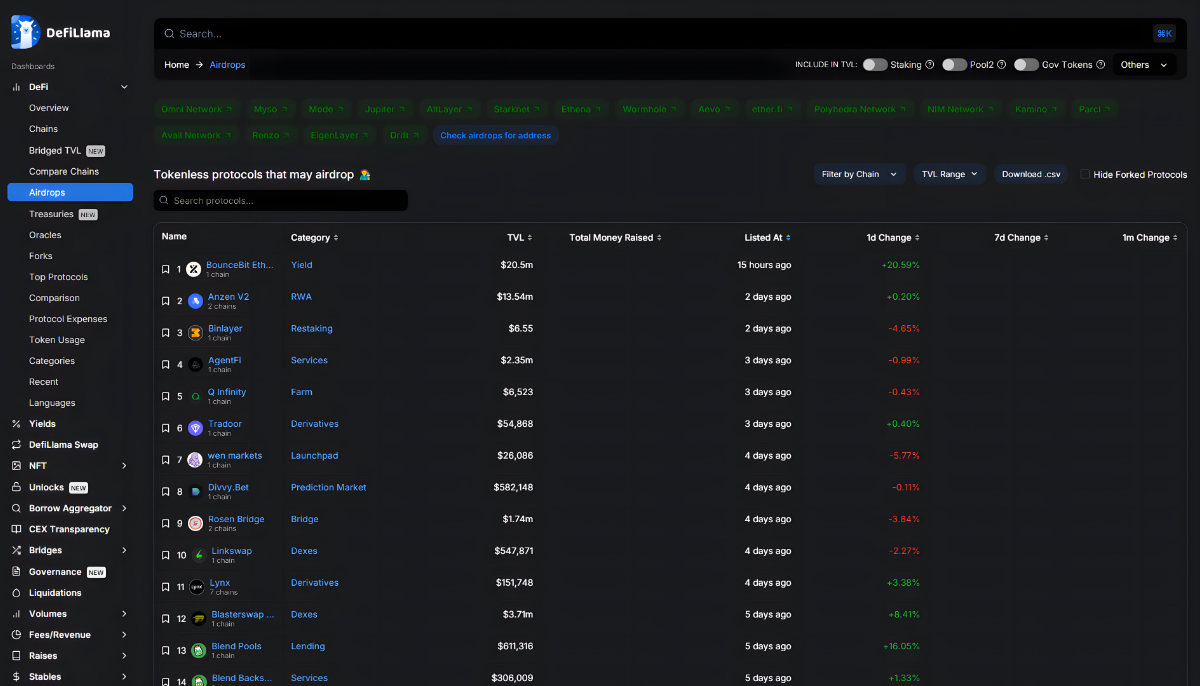
Airdrops offer a way to earn free tokens by participating in various promotions. DeFi Llama can help you discover recent airdrops you might want to join.
It’s like receiving free money simply for holding a particular cryptocurrency or performing a certain action.
For example, when you try out a new app or website, the creators might reward you with their own cryptocurrency tokens as a thank-you gesture.
This helps them attract more users and promote their product.
NFTs
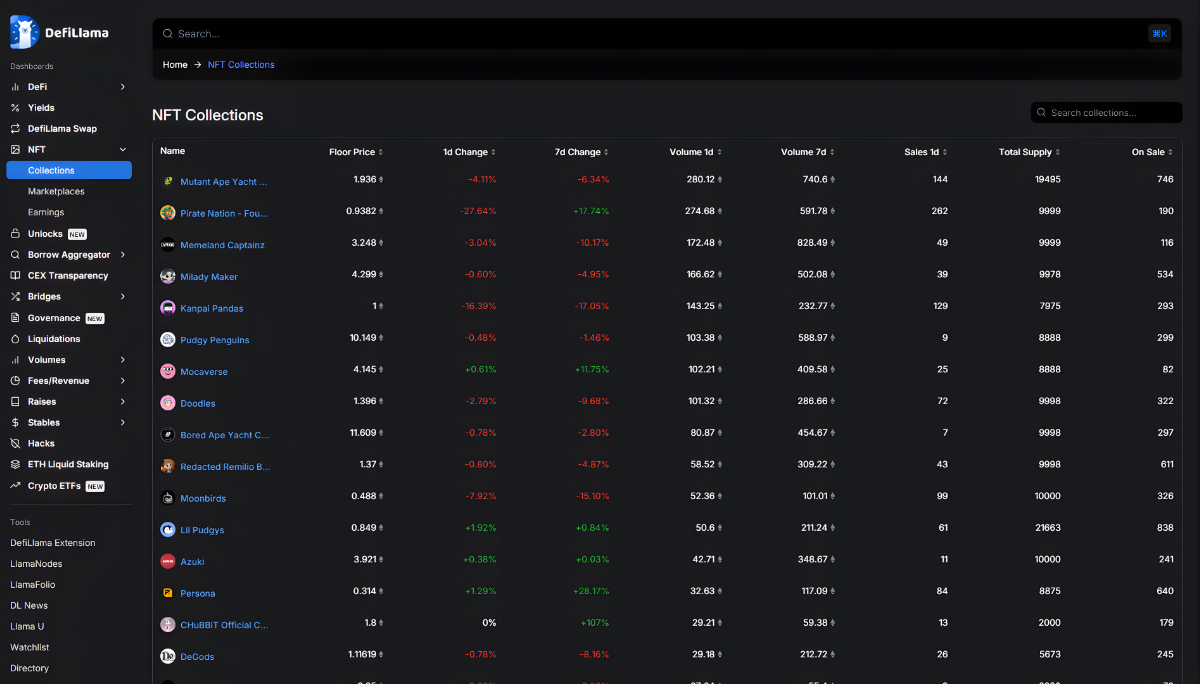
If you’re into NFTs or skilled at flipping them, there are useful tools available for researching them. Personally, I focus more on finance aspects like lending and strategies.
In NFT research, you can explore collections to find details like the floor price, total supply, and available items for sale. Marketplaces show trading volume and activity.
In the earnings section, you’ll find the names of creators, companies, or individuals behind NFT collections. Successful collections often indicate profitable potential for new NFT purchases.
NFT Earnings Metrics
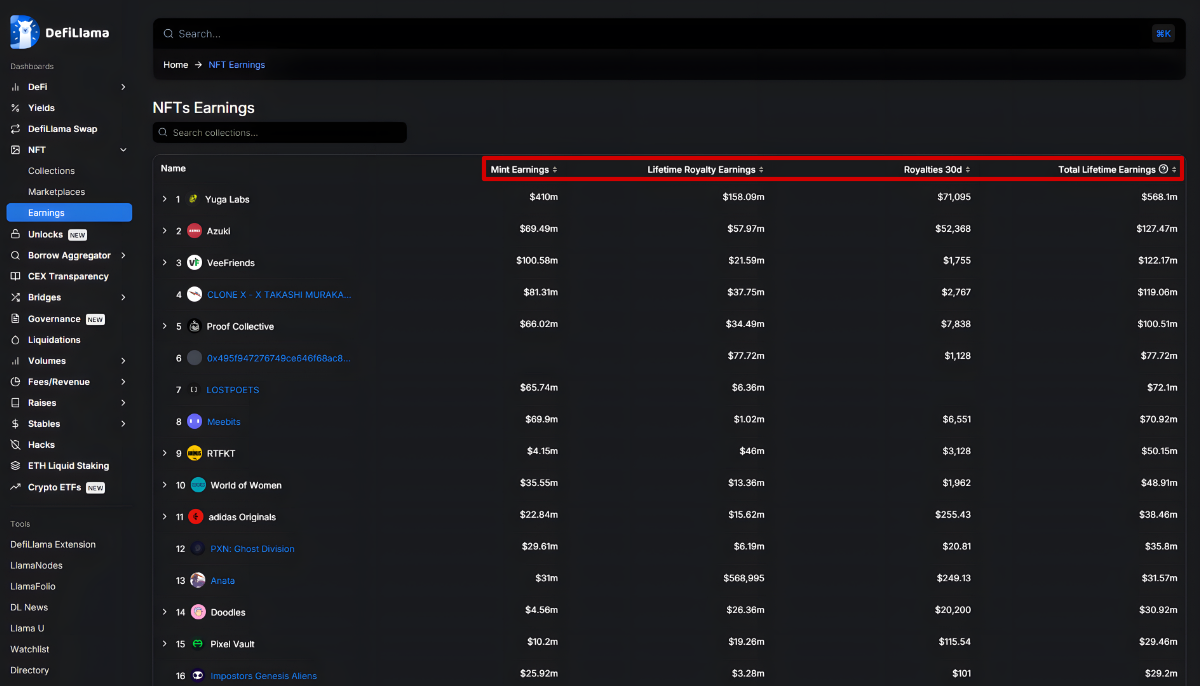
| Metric | Description |
|---|---|
| Mint Earnings | The total money earned by the creator from selling NFTs during the initial minting process. |
| Lifetime Royalty Earnings | The total royalties earned by the creator throughout the lifetime of the NFT, received each time the NFT is resold. |
| Royalties 30D | The total royalties earned by the creator in the last 30 days, indicating recent market performance. |
| Total Lifetime Earnings | The combined total of mint earnings and royalties earned by the creator throughout the lifetime of the NFT project. |
Mint Earnings
This shows how much money the creator of an NFT earned from selling the NFTs during the initial minting process.
When an NFT is created, the creator sets a price and sells it. The total money earned from these sales is the mint earnings. It helps understand the creator’s initial sales revenue from the NFTs.
Lifetime Royalty Earnings
Lifetime Royalty Earning measures the total royalties earned by the creator of an NFT throughout its lifetime.
Royalties are payments creators receive each time their NFT is resold. For instance, if someone buys an NFT for $100 and later sells it for $1,000, the creator might get a percentage of the $900 price increase as a royalty.
This metric helps gauge the creator’s ongoing earnings from NFT sales.
Royalties 30D
Total royalties earned by the creator of an NFT in the last 30 days.
It’s like the lifetime royalty earnings metric, but over a shorter period. It helps understand the NFT’s recent market performance and the creator’s income from recent sales.
Total Lifetime Earnings
Shows the total money earned by the creator of an NFT throughout its lifetime, combining mint earnings and royalties.
It gives a complete picture of the creator’s earnings from the NFT project overall. This metric helps understand the project’s economic success and the creator’s overall financial performance.
Best DeFi Aggregator
DeFi Llama is the best DeFi aggregator dashboard tool in my book. You can find everything DeFi related in this website and explore further the projects or opportunities you are interested in.
Thanks for reading this long article! You should now be equipped to dive into DeFi and be able to analyze all of these metrics and evaluate investments.
Check out the extra resources below if you want to learn more about DeFi Llama and calculate future profits.
